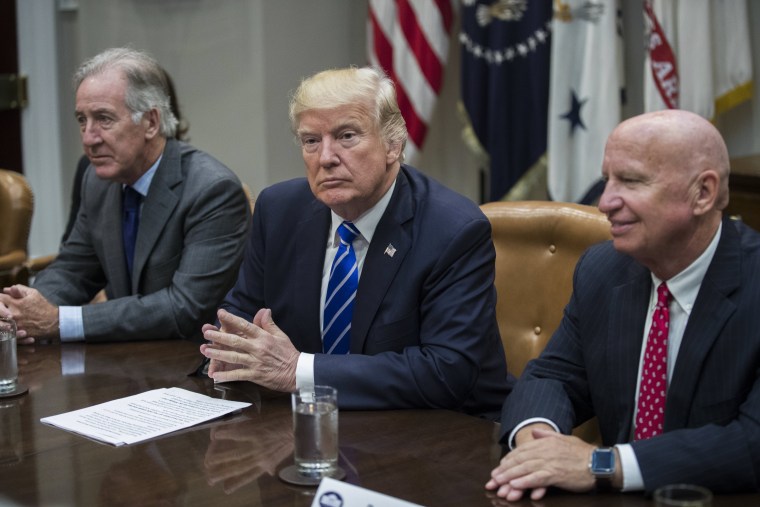It's been five days since Donald Trump first declared publicly that he and congressional Republicans are working "around the clock" on a new tax cut, which would be ready no later than Nov. 1, despite the fact that Congress is effectively out of session. No one in Congress had any idea what the president was talking about, and even White House officials quietly conceded they were "mystified."
But then something funny happened. Republicans, reluctant to admit that the emperor has no clothes, started scrambling to find fabric. The Wall Street Journal reported late yesterday:
Republicans are attempting to turn a vague tax-cut promise floated by President Trump into a campaign plank as they try to hang onto their majority in the House of Representatives. [...]"We will continue to work with the White House and Treasury over the coming weeks to develop an additional 10% tax cut focused specifically on middle-class families and workers, to be advanced as Republicans retain the House and Senate," said Rep. Kevin Brady (R., Texas), chairman of the House Ways and Means Committee.
Brady couldn't just come right out and say, "Everything Trump said is gibberish," so the Texas Republican issued a statement that subtly made clear that the proposal the president referred does not, at present, exist.
But the entire Republican apparatus apparently finds it necessary to pretend that it does exist. The president himself started adding new details to his imaginary plan, telling the Wall Street Journal that the White House has come up with a framework so that a multi-million-dollar tax break won't add to the deficit.
"We have a way," Trump said. "We're going to announce it at the time. But we think we can make it revenue neutral based on certain things."
What "things"? It's impossible to say. Because the plan is fictional, the supporting details that bolster the plan necessarily exist only in the presidential fantasy.
But what's especially striking about this is how often we're confronted with similar circumstances.
The Washington Post had a great piece on this:
The mystery tax cut is only the latest instance of the federal government scrambling to reverse-engineer policies to meet Trump's sudden public promises -- or to search for evidence buttressing his conspiracy theories and falsehoods.The Pentagon leaped into action to both hold a military parade and launch a "Space Force" on the president's whims. The Commerce Department moved to create a plan for auto tariffs after Trump angrily threatened to impose them. And just this week, Vice President Pence, the Department of Homeland Security and the White House all rushed to try to back up Trump's unsupported claim that "unknown Middle Easterners" were part of a migrant caravan in Central America -- only to have the president admit late Tuesday that there was no proof at all."Virtually no one on the planet has the kind of power that a president of the United States has to scramble bureaucracies in the service of whim," said Kathleen Hall Jamieson, director of the Annenberg Public Policy Center at the University of Pennsylvania. "Whatever Donald Trump wakes up and thinks about, or whatever comes to mind in the middle of a speech, actually has the reality in that it is actionable in some odd sense."
In May, Anne Applebaum wrote, "[E]veryone understands now that policy, in Trump's Washington, is often made on a whim -- the president's whim."
The columnist was referring to foreign policy at the time, but it's a sentiment with broad applicability. In traditional administrations, officials do their due diligence first, and once the work is complete, the president makes an announcement. In Donald Trump's White House, it's reversed: the president blurts out a poorly constructed thought, which in turn sends officials scrambling to construct a framework in service of the amateur's idea.
Behold, 21st-century governing in a nation that's supposed to be the world's preeminent superpower.
